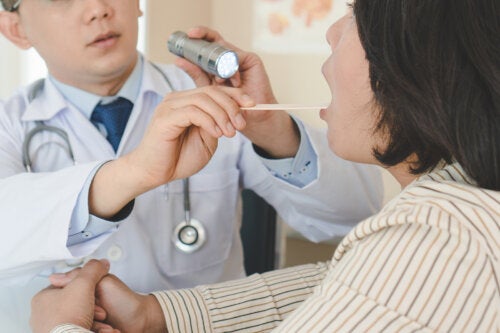
En la mayoría de los casos el cáncer oral se detecta cuando ya está en una fase avanzada.
Esto disminuye las posibilidades de tratar la enfermedad y sobrevivir a ella. La autoexploración bucal es una medida que permite una detección precoz.
La autoexploración bucal es una medida efectiva para ayudar a detectar el cáncer oral de forma precoz. Lo indicado es que también una persona visite a su odontólogo con regularidad.
Las dos medidas en conjunto son la estrategia ideal para identifi car a tiempo cualquier problema.Se ha establecido que el cáncer oral detectado a tiempo incrementa la posibilidad de sobrevivir en un 90 % de los casos.
En cambio, si este cáncer se identifica en las etapas avanzadas, hasta en la mitad de los casos la persona afectada muere a los cinco años.Se estima que el 85 % de los casos de cáncer oral no se diagnostican a tiempo.
De ahí la importancia de hacer una autoexploración bucal de forma regular. Esta es la mejor forma de detectar alguna anomalía, como un bulto o una herida que no sana.
Cómo se debe realizar la autoexploración bucal?
La autoexploración bucal es un procedimiento sencillo que cualquier persona puede llevar a cabo.
En principio, se le puede pedir al odontólogo que dé las instrucciones sobre cómo hacerla. Si esto no es posible, de todos modos existen algunos pasos simples para realizarla.
Lo indicado es hacerse la autoexploración bucal por lo menos una vez cada seis meses. Se necesita una luz de linterna, un espejo y el mango de una cuchara para facilitar la visibilidad desde todos los ángulos. Lo recomendable es seguir estos pasos:
Observar los labios. Se deben observar por la cara interna y externa. La mucosa debe ser rosada y brillante. La presencia de manchas, bultos, lesiones o nódulos es una señal que debe tomarse en cuenta.
Las mejillas. Con ayuda del mango de una cuchara y la linterna, se debe explorar la cara interna de las mejillas. No debe haber manchas o lesiones. Si falta una muela, es posible que haya una protuberancia en la zona que coincide con ese hueco.
El paladar. En este caso se debe emplear un espejo y la linterna para obtener buena visibilidad. La tonalidad debe ser rosa, un poco más oscura en la zona posterior. Si la persona tiene amígdalas palatinas, estas también deben verse rosadas y brillantes.
Las encías. En ellas no debe haber bultos ni manchas. Tampoco deben ser sensibles al tacto ni sangrar. El color también debe ser rosa brillante.
Los dientes. Se examinan para detectar manchas, puntos o, incluso, pequeñas roturas o fi suras. El color debe ser amarillento o blanco. Una dentadura sana se ve de color marfil.
La lengua y el suelo de la bocaLa lengua y el suelo de la boca merecen un capítulo aparte en la autoexploración bucal. La primera es una de las estructuras más importantes de la boca y constituye un importante indicador de posibles enfermedades.
Por lo mismo, hay que explorarla con cuidado.
Oral self-examination: oral cancer preventive measure
In most cases, oral cancer is detected when it is already in an advanced stage. This decreases the chances of treating and surviving the disease. Oral self-examination is a measure that allows early detection.
Oral self-examination is an effective measure to help detect oral cancer early. A person should also visit his or her dentist regularly. The two measures together are the ideal strategy to identify any problems early.
It has been established that oral cancer detected early increases the chance of survival in 90% of cases. On the other hand, if this cancer is identified in advanced stages, in up to half of the cases the affected person dies within five years.
It is estimated that 85 % of oral cancer cases are not diagnosed in time. Hence the importance of regular oral self-examination. This is the best way to detect any abnormality, such as a lump or a wound that does not heal.How should an oral self-examination be performed?
Oral self-examination is a simple procedure that anyone can perform. In principle, you can ask your dentist for instructions on how to do it. If this is not possible, there are still some simple steps to perform it.
It is best to perform an oral self-examination at least once every six months. You will need a flashlight, a mirror and a spoon handle to facilitate visibility from all angles. It is recommended to follow these steps: Observe the lips. They should be observed by the internal and external face. The mucosa should be pink and shiny.
The presence of spots, lumps, lesions, or nodules is a sign that should be taken into account. The cheeks. With the help of a spoon handle and flashlight, explore the inside of the cheeks. There should be no spots or lesions. If a tooth is missing, there may be a lump in the area that coincides with that gap.
Palate. In this case, a mirror and flashlight should be used to obtain good visibility. The shade should be pink, a little darker in the posterior area. If the person has palatine tonsils, these should also look pink and bright.
The gums. There should be no lumps or spots on the gums. They should not be tender to the touch or bleed. The color should also be bright pink.
Teeth. They are examined for stains, spots, or even small breaks or cracks. The color should be yellowish or white. Healthy teeth look ivory in color. The tongue and floor of the mouth.
The tongue and the floor of the mouth deserve a separate chapter in oral self-examination. The tongue is one of the most important structures in the mouth and is an important indicator of possible diseases. For this reason, it should be carefully explored. Dr. Hector LinaresAutoexploración bucal: medida preventiva de cáncer oral•Oral self-examination: oral cancer preventive measure25
